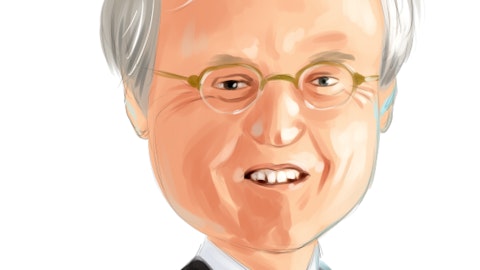The big difference between Q3 and Q4 is now we’re assuming that repair to be flattish in the fourth quarter and Mod growing double-digit. So that is a mixed impact which is leading for the margins to be lower, but net-net, we’re exiting the year at what we guided, so feel pretty good about it on the service side.
Judy Marks: Yes, Julian, on the second question where you’re talking about wages and inflation, inflation on the service side, while we have had wage inflation, you know, we know we need to offset that with productivity, and what we’ve been doing with price has been fairly significant. We have another quarter where our service pricing, like-for-like is up 4 points, and with inflation staying pretty high, especially in EMEA and in the Americas, we should be able to as we negotiate the majority of our maintenance contracts, you know, first, second quarter next year, which are mainly backward looking for this year’s inflation, we expect to be able to get price again at levels comparable to that for 2024. We have line of sight now, the majority of our ‘23 maintenance contracts are in the books, as our commodity prices and everything else as we go with 2.5 months left to go now.
So we’re actually feeling pretty good about service pricing for next year and price cost. And we’ve negotiated with the majority of our collective bargaining across the globe. Most of our mechanics are represented. And I think, I know we’ve treated them fairly and we’re able to recover that in both price and productivity.
Julian Mitchell: Great, thank you.
Operator: Please stand by for the next question. The next question comes from Joe O’Dea with Wells Fargo. Your line is open.
Joe O’Dea: Hi. Good morning. Thanks for taking my questions. I wanted to circle back to the backlog comments and could you just expand on how much of next 12-months revenue you generally have visibility into based on backlog levels and talk about that in America’s and Europe and then in China. And in particular in China, then the mix that would be coming out of backlog and the mix would be book-and-ship and what you’re seeing in some of those book-and-ship trends recently?
Anurag Maheshwari: Yes, absolutely. If you look at a backlog, it is significantly more than a 12-month revenue, because we got major projects in there. We have other kind of long-tailed projects as well. But very specifically, the reason why I said earlier we have confidence of America and Europe, kind of, growing low-single-digit next year is the back half — even if we snap the line today, we have very high visibility of that converting. We enter any political year with 80%, 90% of America’s and EMEA revenue coming out of backlog. Followed by that is Asia-Pacific Ex-China, which is probably a little bit lower, depending upon the geography mix, but that backlog is up very healthy. It’s probably double-digit up, right? Then China is the only one where we have higher book-and-ship.
So when we enter the year, I would say two-thirds of that revenue probably comes from the backlog and a third comes from the book-in-ship, which is why for three out of four regions, we feel it’s low-single-digit growth for next year. China is the only variable that we need to see how the next few month’s go.
Joe O’Dea: Got it. That’s helpful. And then just some perspective on where China volumes are. Can you talk about for the total market where unit volumes have been over the last several years where they’re trending this year? How you think it’s setting up in terms of next year for some perspective on the current softness relative to recent strength?
Judy Marks: Yes, Joe, we would tell you that, you know, if you go back to peak years in China, we probably peaked the segment, peaked new equipment at about 650,000 units. That’s been coming down now for the past two years, and we’re at about 450,000 currently for this year. Still 450,000 of the 850,000 global units. So still a large healthy market. And 450,000 you’d probably have to go back to 2018-ish timeframe to where we had, you know, obviously pre-COVID to having a market like this. And so we still think it’s a very attractive market. We’ve gained share there this year as we look in China and we will continue to execute our strategies of our agents and distributors being our partners, which we now have about 2,350 agents and distributors, more than twice since we spun.
We focus on our key accounts. And we’ve also really focused on the Tier cities that are having an impact. So if you look at the third quarter, Tier 1 cities, Beijing, Shanghai had the best market segments. And then, you know, obviously it trailed off as you got all the way to Tier 5. So we’ve adjusted our strategy. That’s why our agents and distributors are so helpful, as well as our internal sales folks that support them. The key accounts, again, those relationships are strong, and they are yielding for us.
Joe O’Dea: Thank you. I appreciate the details.
Operator: Please stand by for the next question. The next question comes from Steve Tusa with JPMorgan. Your line is open.
Steve Tusa: Hey, good morning.
Anurag Maheshwari: Hey, good morning, Steve.
Steve Tusa: You mentioned the trends of what’s going on in China. I think one of your competitors had some pretty big orders numbers there today. Can you maybe help reconcile that? Because I think you guys are obviously, I think you were down, but maybe could you just maybe help reconcile what the difference might be? Obviously, any quarter there’s some lumpiness, but just curious from a share perspective there, just trying to tie those two things together.
Judy Marks: Yes, I think you’re going to, I mean, orders are lumpy, kind of, across the board for both modernization and new equipment. And I would argue share is also, kind of, hard to measure on a quarterly basis and something more you’d like to do on an annual level when you really have some fidelity in the information. I can’t comment on what our competitors are doing, but I can tell you that, you know, we’re, again, our China team is executing our strategy. In a down market, you know, our China team has both driven cost out in terms of material productivity. So that, again, if you look at and you step back, you know, we’re driving growth in all lines of business in Otis, especially in service. We’re seeing good growth in three regions outside of China.
But our China team has really in despite a tough macro environment on new equipment, has really now added this service component, which now we’re at 365,000 units in our portfolio in China, more than double from when we spun. And our China modernization business has grown double-digits this year. So we’re finding we’re moving Mod into the factory, so we’re optimizing the cost basis there, and you’re going to see that modernization business really in China, as well as globally take off. And for us, we need to watch that mix. That’s what Anurag commented on for fourth quarter for service margins. But we think, we know it’s actually worth getting that modernization business, because it will bring more units to our portfolio. So we’re going to end this year at 2.3 million units in our portfolio.



